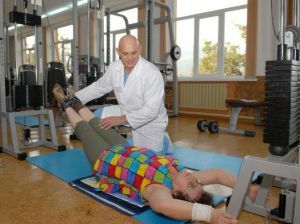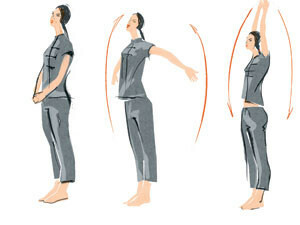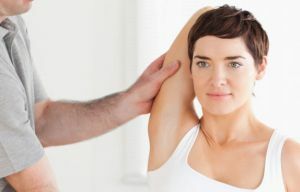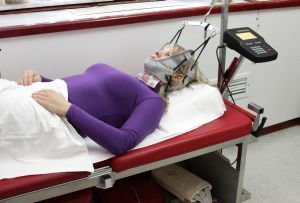 Extension of the spine is a procedure known to mankind for many centuries. Even in the time of Hippocrates, healers of many countries were interested in this kind of treatment, and the father of medicine himself successfully practiced so-called rickhitotherapy.
Extension of the spine is a procedure known to mankind for many centuries. Even in the time of Hippocrates, healers of many countries were interested in this kind of treatment, and the father of medicine himself successfully practiced so-called rickhitotherapy.
In our time, traction( which in Latin means "traction") - the reception is well-known, is performed with the help of special equipment and gives good results.
Much credit goes to the notorious medical professor K. Kinlein who designed and introduced the world to his wonder-mattress Detensor.
His motto is a comfortable, non-violent stretching of the spine.
Did you notice how with age, people become lower? This is due to the fact that the intervertebral discs, which serve as pads between the vertebrae, lose their elasticity. This process causes degenerative-dystrophic changes( osteochondrosis).
Closer, they squeeze the roots of the nerves, which then become inflamed, swell and pain occurs in different parts of the spinal cord.
If at this stage a person does not seek help from a qualified specialist, the intervertebral discs may begin to bulge, so the intervertebral hernia appears.
The patient feels pain, sometimes giving to other organs, numbness of the upper or lower extremities( depending on the type of hernia), atrophy and weight loss of the legs.
The last symptom is associated with poor supply of muscles with oxygen and nutrients. Other signs may also join, not always associated with the presence of a hernia: blood pressure jumps, muscle tension, memory disorders, attention and even constipation, urination disorders.
The content of the article
- Therapeutic spinal traction
- In what cases is the therapy used?
- When the traction is unacceptable
- The essence of the
- treatment Pros and cons of the
- procedure Satisfied patients are increasingly
Spinal traction
Miorelaxation traction therapy is a type of treatment for spine diseases by traction-stretching under the influence of the body weight of the patient or additional weights.
Used for the purpose of spacing the intervertebral discs from one another. This kind has many advantages and advantages over other species.
Special couches or traction tables are used for stretching. The patient must undergo a full course of treatment, the number of sessions is selected individually for each patient.
The main types of therapy are dry and underwater traction .In this submarine - more sparing and completely painless, because under the influence of water at room temperature, there is relaxation of muscles and removal of spasms.
Dry - often carried out with the help of computer control, which provides an ideal selection of the load.
During stretching on the traction table, the patient is in the Fowler position, that is, bending his legs in the knees, feet - on the step.
The table is divided into segments, which allows you to alternate tension and relaxation cyclically on different parts of the spinal column. Often has a special mode - vibration, which provides a relaxing massage.
Depending on the position of the patient's body, the distinguishes between vertical and horizontal traction, as well as traction on an inclined plane.
The horizontal passes on the above-mentioned couches, and a number of other devices are used to make the vertical beds.
For example, for problems with the cervical spine, traction is performed using the Glisson loop and the patient sits on a special chair.
Before the procedure, the doctor appoints an examination in different specialists and an X-ray examination.

When are therapies used?
Indications for use:
- Intervertebral hernias and protrusions.
- Scoliosis, kyphosis.
- Degenerative - dystrophic processes in the spine. This includes: osteochondrosis, which is characterized by a decrease in the height of the intervertebral discs. Spondylarthrosis is a neglected stage of osteochondrosis.
- Radiculitis, lumbago.
- Muscle spasm
- Bechterew's disease( only the initial stages).
- Pain after a back injury.
 The safest operation to remove the intervertebral hernia microdiscectomy - what indications and contraindications to the procedure.
The safest operation to remove the intervertebral hernia microdiscectomy - what indications and contraindications to the procedure. Discogenic radiculopathy is a dangerous pathology that can cause paralysis and complete immobility of the spine. What methods of therapy exist?
When traction is unacceptable
Contraindications:
- the age of the patient should not exceed 60 years, but should not be less than 15;
- pain syndrome in acute period;
- tumor or metastasis in the spine;
- circulatory disturbance in the spinal cord;
- diseases of the cardiovascular system;
- kidney disease;
- mental illness in the acute stage;
- infectious diseases;
- general severe condition;
- pregnancy.
The essence of the treatment
It is common knowledge that the lion's share of all back pains is compression of the vertebrae of the roots of the spinal cord.
As a result of this, the roots have the ability to occupy the original or more comfortable place. Also, blood circulation is improved - which means that the entire spine system is fed.
Pros and Cons of the
Procedure Let's start with the cons: the most important drawback of the procedure is trauma danger.
To avoid injury, the specialist adds and reduces the load gradually. 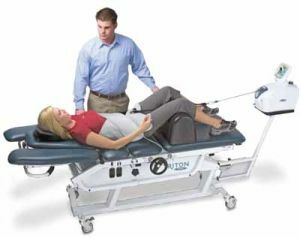
The benefits of the procedure are many, but the most significant advantage is the ability to cure spine diseases without resorting to surgical interventions.
It is also worth noting that the procedure is completely painless. If the pain arises, then the load is not selected correctly.
Satisfied patients more
Reviews of patients who underwent traction therapy of the spine, as well as specialists who use it in their practice.
I underwent underwater traction treatment. Before treatment well weighed the pros and cons. My sister is a doctor, and she advised me exactly the underwater type of traction.
All this, of course, has one minus - it takes a long time, because after the course of treatment you can not lift heavy objects, move abruptly. But it was worth it. Two years have passed since my osteochondrosis does not bother me at all!
I did not think it would be possible, but the result is really good. "
Natalia Bezredko, 44, patient
The intervertebral hernia tormented me for a long time. It hurt to move, walk and even sit, and this became a huge problem, since my work is sedentary.
I almost always felt pain in the lower back, but did not go to the doctor. Somehow after work, I was very surprised to find a slight numbness in my legs! Thinking that I could lose the opportunity to move, I ran to a specialist.
I was lucky to have an excellent doctor who advised the extension of the spine. What immediately pleased me was the feeling of comfort during the meeting, although I expected that it would be unpleasant.
After three or four procedures, the improvement came, and after a full course I generally forgot about problems with the back.
Alexander Nikolaev, 56 years old, patient
After the patient undergoes a full medical examination, MRI procedure of the spine and X-ray examination, we often assign traction therapy.
Sometimes I hear bad reviews, all of them perceive with a smile, because I know if during the stretching the patient is watched by an experienced doctor, and the patient outside the hospital strictly observes all the rules - the result will always be positive!
But often it's different, after the first session they begin to raise their weights, get up off their bed, lead a normal life. This is the main cause of the negative consequences.
At the same time, I know many cases where patients with severe injuries and diseases of various parts of the spinal column were rehabilitated and recovered on the background of traction therapy.
Eugene Lebedev, 39, orthopedist
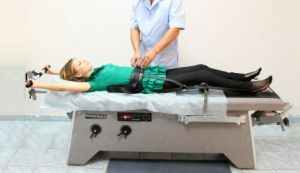 An experienced doctor will select and prescribe a course of massage or gymnastics, to fix the result.
An experienced doctor will select and prescribe a course of massage or gymnastics, to fix the result.
During water stretching it can be water gymnastics, helping to quickly restore the body.
And remember, the best results from therapy in people who have started treatment at an early stage, so do not delay the moment and take care of your health today!

